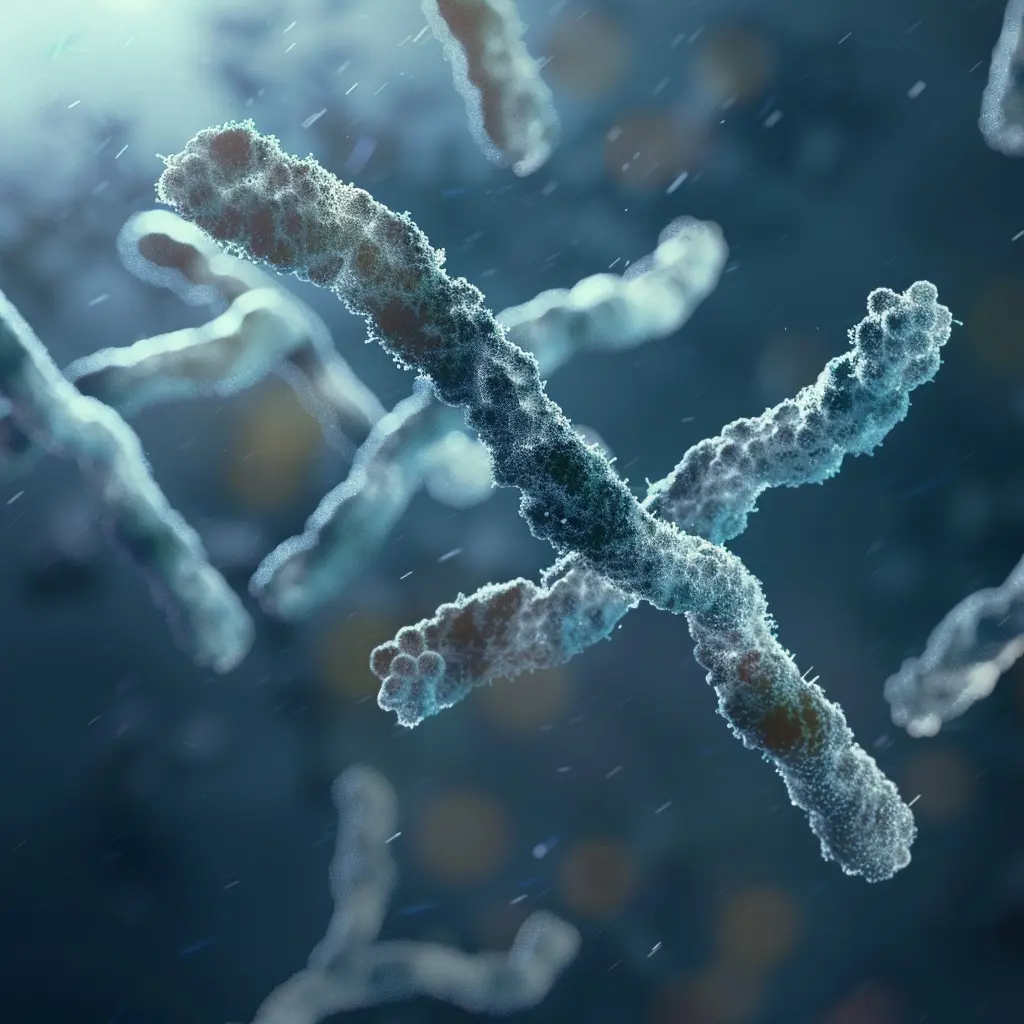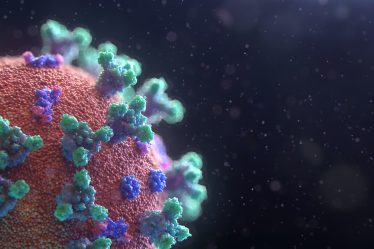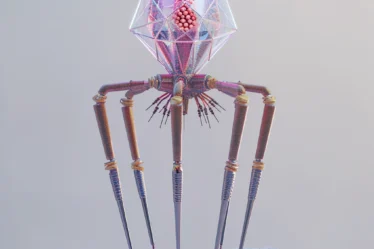
Have you ever wondered why children inherit traits from their parents, like eye color or height? The answer lies in chromosomes, the thread-like structures inside cells that carry genetic instructions. Each parent passes down 23 chromosomes, forming the unique blueprint that shapes every individual.
This study guide explains chromosomes, the XY chromosome system that determines biological sex, and aneuploidy, which refers to an abnormal chromosome number. You’ll learn how chromosomes are structured, how they pass from parents to offspring, and how errors during cell division can lead to genetic conditions.
Chromosomes: Quick Summary
Do you just need the basics? Here’s a simple explanation of what chromosomes are:
🟠 Chromosomes are thread-like structures made of DNA and proteins, found in the cell nucleus, carrying genetic information.
🟠 The XY chromosome system determines biological sex, with XX for females and XY for males.
🟠 Aneuploidy refers to an abnormal number of chromosomes, often caused by errors during cell division.
🟠 Karyotyping, FISH, and PCR are common methods used to detect chromosomal abnormalities.
🟠 Chromosomal disorders, such as Down syndrome, result from extra or missing chromosomes, affecting development and health.
What Are Chromosomes?
Chromosomes are thread-like structures in cells that store genetic information. Each chromosome consists of DNA tightly wrapped around histone proteins, forming chromatin. This structure allows long DNA molecules to fit inside the cell nucleus while keeping genetic material organized and accessible.
Eukaryotic cells have linear chromosomes located in the nucleus, while prokaryotic cells have a single circular chromosome floating in the cytoplasm. Each chromosome has a centromere, which holds sister chromatids together during cell division, and telomeres, which protect the ends from damage.
When a cell prepares to divide, chromatin condenses into chromosomes. Each chromosome then duplicates, forming two identical chromatids connected by the centromere. The cell’s spindle fibers pull these chromatids apart, ensuring that each daughter cell receives an identical set of chromosomes. Errors during this process can lead to conditions like aneuploidy, where cells have an abnormal number of chromosomes, affecting development and health.
Chromosome Structure and Function
Chromosomes are tightly packed structures that store genetic material in cells. They form when DNA wraps around histone proteins, creating chromatin. This arrangement allows nearly two meters of DNA to fit into the tiny cell nucleus, which measures only a few micrometers across.
The basic unit of chromatin is the nucleosome, where DNA coils around a core of eight histone proteins. These nucleosomes link together, forming a fiber that further coils to create chromosomes visible during cell division.
Each chromosome has distinct parts:
- Centromere: The region where sister chromatids attach and spindle fibers connect during cell division.
- Telomeres: Repeated DNA sequences at chromosome ends that protect genetic material from damage.
Chromatin exists as euchromatin or heterochromatin. Euchromatin is loosely packed and allows active gene expression, while heterochromatin remains tightly packed and less active.
| Feature | Euchromatin | Heterochromatin |
| Structure | Loosely packed | Densely packed |
| Gene Activity | Active | Inactive |
| Staining (in microscopy) | Light | Dark |
| Location | Interior of the nucleus | Periphery of the nucleus |
Proper DNA packaging ensures organized genetic material, accurate replication, and controlled gene activity. Errors in this structure can lead to aneuploidy, where cells have an abnormal number of chromosomes.
How Chromosomes Control Gene Expression
Chromosomes not only store genetic information but also control when and how genes are expressed. This process depends on the structure of chromatin, the DNA-protein complex that makes up chromosomes. Chromatin exists in two forms: euchromatin and heterochromatin.
Euchromatin is loosely packed, allowing the cell’s machinery to access genes for transcription, the first step in protein synthesis. Genes in euchromatin are active and can produce proteins that influence cell function and development. In contrast, heterochromatin is tightly packed, making genes in these regions less accessible and often inactive.
Gene expression also depends on regulatory elements within chromosomes. Promoters, enhancers, and silencers are specific DNA sequences that interact with proteins to either activate or suppress gene activity. For example, a promoter signals where transcription should start, while an enhancer boosts the process, and a silencer prevents it.
Chemical modifications of histone proteins, like acetylation or methylation, further influence chromatin structure and gene activity. Acetylation usually loosens chromatin, promoting gene expression, while methylation can either activate or repress genes, depending on the context.
Errors in these regulatory mechanisms can lead to abnormal gene expression, contributing to genetic disorders and some cancers. Understanding how chromosomes regulate genes helps explain how cells develop, function, and respond to their environment.
How Do Chromosomes Pass from Parents to Offspring?
Chromosomes transfer genetic information from parents to offspring through meiosis, a type of cell division that produces sperm and egg cells. Each human gamete carries 23 chromosomes, half the number found in other cells. When an egg and sperm combine during fertilization, they form a zygote with 46 chromosomes, organized into 23 pairs.
Chromosome Types in Inheritance
- Autosomes: The first 22 chromosome pairs determine most genetic traits, such as eye color and height.
- Sex Chromosomes: The 23rd pair determines biological sex—females have two X chromosomes (XX), while males have one X and one Y (XY).
During meiosis, homologous chromosomes separate, ensuring that each gamete gets one chromosome from each pair. This random assortment leads to genetic variation among siblings. Errors in chromosome separation can lead to conditions like aneuploidy, where cells have an abnormal number of chromosomes, affecting development and health.
In humans, the XY chromosome system determines sex. A child inherits an X chromosome from the mother and either an X or Y chromosome from the father. If the sperm carries an X, the child will be female (XX). If it carries a Y, the child will be male (XY).
Understanding the XY Chromosome System
The XY chromosome system determines biological sex in most mammals, including humans. Males have one X and one Y chromosome (XY), while females have two X chromosomes (XX). The father’s sperm determines the child’s sex. If the sperm carries an X chromosome, the child will be female (XX). If it carries a Y chromosome, the child will be male (XY).
X vs. Y Chromosome Structure and Genes
X Chromosome: Larger, with about 1,100 genes involved in development, metabolism, and other cellular functions.
Y Chromosome: Smaller, with around 55 genes, mainly controlling male traits and sperm production.
The SRY gene on the Y chromosome triggers male development. Without it, the embryo follows the female developmental path.
Chromosome Combinations
XX: Female XY: Male
In humans and animals, this system consistently defines sex. Rarely, errors during cell division cause aneuploidy, like Turner syndrome (XO) or Klinefelter syndrome (XXY), affecting physical traits and fertility.
Chromosomal Abnormalities and Aneuploidy
Aneuploidy refers to an abnormal number of chromosomes in a cell, often caused by errors during meiosis. Normally, human cells have 46 chromosomes, but aneuploidy can result in cells with missing or extra chromosomes. This usually happens due to nondisjunction, where chromosomes fail to separate properly. Environmental factors, such as radiation or toxins, can also increase the risk.
Common Types of Aneuploidy
Different conditions arise depending on which chromosomes are affected. Trisomy 21, known as Down syndrome, results from an extra copy of chromosome 21, leading to distinctive physical features and varying degrees of intellectual disability. Turner syndrome occurs when a female has only one X chromosome (45, X), causing short stature and delayed puberty. Klinefelter syndrome (47, XXY) affects males, often resulting in tall stature, reduced fertility, and some learning difficulties.
Autosomal vs. Sex Chromosome Aneuploidy
Aneuploidy affects autosomes and sex chromosomes differently. Autosomal aneuploidies, like trisomy 21, 18, or 13, usually cause more severe health problems and often lead to miscarriage. In contrast, sex chromosome aneuploidies tend to have milder effects. For example, people with an extra X or Y chromosome often live healthy lives with minimal symptoms.
Mosaic Aneuploidy
Mosaicism occurs when some cells have abnormal chromosome numbers while others remain normal. This can lead to less severe symptoms, such as in mosaic Down syndrome. Early detection through prenatal testing helps identify chromosomal abnormalities and prepare for potential health challenges.
How Are Chromosomal Disorders Detected?
Doctors use several methods to detect aneuploidy and other chromosomal disorders. Karyotyping is the most common technique. It involves staining and examining chromosomes under a microscope to identify abnormalities in number or structure. This method can easily detect conditions like Down syndrome, Turner syndrome, or Klinefelter syndrome.
Fluorescence in situ hybridization (FISH) offers more precise results. It uses fluorescent probes that bind to specific chromosome regions, making it easier to find smaller changes that karyotyping might miss.
Polymerase chain reaction (PCR) amplifies DNA segments to detect genetic mutations or chromosomal imbalances quickly. This method is often used alongside other tests for confirmation.
Prenatal screening, such as amniocentesis or chorionic villus sampling (CVS), allows doctors to check for aneuploidy during pregnancy. These tests, combined with genetic counseling, help parents understand the risks and implications of chromosomal abnormalities.
Chromosome Tutoring for Clear and Confident Learning
If you’re struggling to get a clear grasp of chromosomes, how they work, or what happens when something goes wrong, personalized tutoring can make all the difference. Sometimes, classroom explanations move too fast or skip the details that help everything click. That’s where one-on-one lessons come in.
A private biology tutor in London can break down topics like the XY chromosome system and aneuploidy, explaining each step in a way that actually makes sense. Instead of memorizing facts, you’ll understand why chromosomes matter in genetics and how they affect traits and health. It’s about learning the “why” behind the science, not just the “what.”
Tutoring sessions adapt to your pace. Need more time with meiosis? No problem. Want to focus on chromosomal disorders? That’s covered, too. With private tutoring, you decide what gets attention.
Looking for biology tutoring in Birmingham or nearby? Find a tutor who can explain genetics clearly, answer your questions, and prepare you for exams. It’s easier to succeed when someone’s guiding you through the tricky parts.
Get in touch today on meet’n’learn for tailored chromosome tutoring in Sheffield and start studying smarter, not harder.
Looking for more resources? Check out our Biology blogs for additional learning material. If you’re ready for extra help, a tutor can guide you through the most challenging topics with clarity and patience.
Chromosomes: Frequently Asked Questions
1. What are chromosomes?
Chromosomes are thread-like structures made of DNA and proteins, located in the cell nucleus, carrying genetic information.
2. How many chromosomes do humans have?
Humans have 46 chromosomes, arranged in 23 pairs, with one set inherited from each parent.
3. What is the XY chromosome system?
The XY chromosome system determines biological sex, with females having XX chromosomes and males having XY chromosomes.
4. What causes aneuploidy?
Aneuploidy occurs when chromosomes fail to separate properly during cell division, leading to extra or missing chromosomes.
5. What are common examples of aneuploidy?
Common examples include Down syndrome (trisomy 21), Turner syndrome (45, X), and Klinefelter syndrome (47, XXY).
6. Can chromosomal abnormalities be detected before birth?
Yes, prenatal tests like amniocentesis, chorionic villus sampling (CVS), and non-invasive screenings can detect chromosomal abnormalities.
7. How do chromosomes affect genetic inheritance?
Chromosomes pass genetic information from parents to offspring through gametes (sperm and egg) during fertilization.
8. Do all living organisms have the same number of chromosomes?
No, chromosome numbers vary across species; for example, humans have 46, fruit flies have 8, and dogs have 78.
Sources:
1. NIH
2. Britannica
3. Wikipedia



